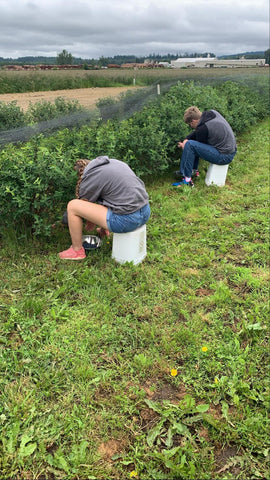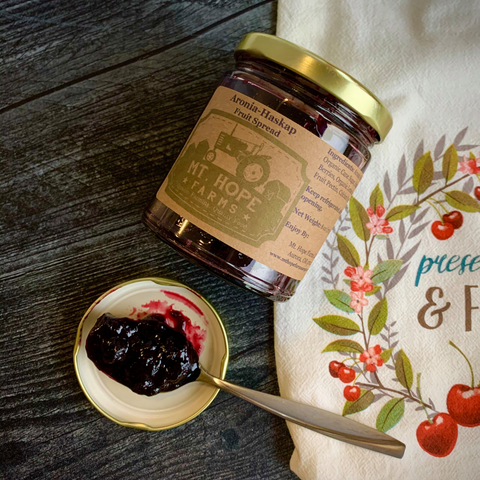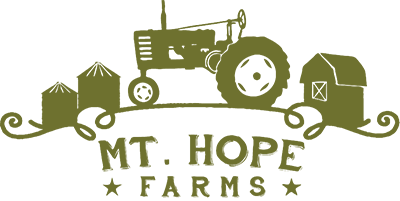At Mt. Hope Farms, we get a lot of questions about our speciality crops, like our Haskap berries! So for all of you who have never eaten this exquisite berry, let us tell you why we like them. The Haskap berry is a dark blue fruit with a skin texture that resembles an elongated blueberry. When ripe, you will find a surprise inside! Slice open the berry where you will find a deep purplish red color, similar to a kiwi.
What do the haskap berries taste like?
Haskap berries are also called Honeyberries, Blue Honeysuckles, Edible Honeysuckles, Canadian Honey Berry and Sweet Berry in different regions. The haskap is a circumpolar species native to the northern boreal forests in Asia, Europe, and North America. The plants themselves look much like a blueberry plant and some varieties can grow up to 6 feet tall, Most, however, are between 4 and 5 feet. They are quite hardy when planted in the right environment.To us, the haskap berry tastes like a cross between raspberry, blueberry and rhubarb. It’s a very tart berry when eaten freshly picked. Our family eats them straight out of the field. We use the majority of the berries for our fruit spreads, a type of low sugar jam, and this sweetens them up a bit.
What are the health benefits?
In Japan, haskap is called 'the fruit of longevity’ but its name means "little present on the end of a branch. Haskaps are considered a superberry because they are extremely rich in nutrients and antioxidants that help fight disease and cancer. According to Bryce Wylde, a leading alternative health expert, when added to a healthy diet and active lifestyle, haskap is believed to affect heart disease, cancer, cardiovascular disease, diabetes, osteoporosis and neurodegenerative diseases.
How do we use haskap berries?
We use our berries in fruit spreads, smoothies, mixed in yogurt, ice cream or fresh from the vine. In Canada, where haskap is more widely grown, the berry is also used in wines, syrups, salad dressings, in dried smoothie powders, and even, beauty products. They are amazingly versatile and we can’t wait to establish a larger crop to begin experimenting!
In 2018, 2020, and 2022 we were honored to win a Good Food Award for our Aronia-Haskap Fruit Spread. It is not unusual for us to sell out within a few days of listing the spreads on our online shop! We are one of the first growers of haskap berries in the Pacific Northwest. Our plants are from specialty breeders in Oregon and Saskatchewan, Canada. We have several haskap varieties, otherwise the flowers cannot pollinate. At least two varieties of haskap, planted in close range, are necessary for successful pollination. Our ripe haskap berries - ready to pick varieties - have been selected as best fits for our soil type, climate and yield potential. We are picky in choosing which types to plant on our farm. It has taken a lot of trial and error over the last few years, to insure we get the most berries possible. As farmers, we choose crops which can help improve our land and that will respond well to our biological farming methods (we’ll have to explain more about these methods in another blog down the road.)
Mason Bees and Pollinators
Over the years, we have implemented a practice to insure our haskaps grow and pollinate well in the early spring. We hired Mason Bees to make the farm their home. (OK, we didn't hire them, but we made them a pretty good deal.) These bees are some of the earliest pollinators in our area of Oregon. We provided houses for them (see the picture below) and they moved in!
The homes are placed near our early blooming crops. We also do everything we can to provide food and a home for all pollinators, bumblebees, honeybees, etc. We certainly aren’t going to turn away any pollinators willing to help us out on the farm.

Soil. Sun. Harvest.
Our farm has been the perfect growing environment for haskap plants because they love growing where water is readily available and the soil is well drained. Haskaps flower early in the spring under a canopy of full to partial sun. The berries usually ripen in late May, earlier than most strawberries in Oregon. We hand harvest our crop. Hopefully, we will have a more efficient system in place. For now, they are harvested one berry at a time. We hand sort the berries to get the best fruit for our products and fresh eating.
Want to follow along with our farming adventures and learn more?
Want to know more about haskap? Be sure to follow us on Instagram and Facebook- where we post about our products, our fruits, how we farm, and care for our land and crops.You can also become part of our farm family and get updates, recipes and the inside scoop from Mike and Laura by jumping on our email list!



At New Seasons Market, our produce staff and customers look forward to receiving your amazing grapes each fall! David Holcomb and I are planning to attend your Vineyard Day on Thurs 8/25. See you then!
Steve Radtke on
Thanks for this informative post! A friend in Canada just ordered several Haskap plants for her place in Quebec. The early harvest will be a real boon for her short growing season.
Jane on